apogee
Latest
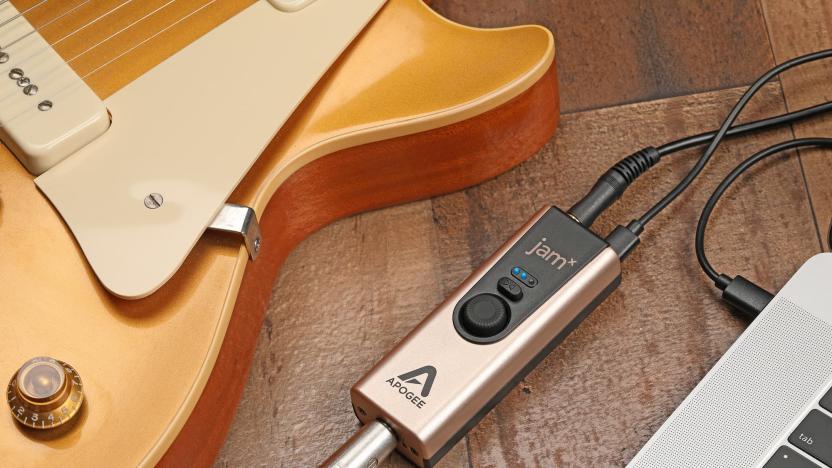
Apogee's latest Jam interface has a built-in analog compressor
The JamX has three three analog compression presets to help you shape your tone.
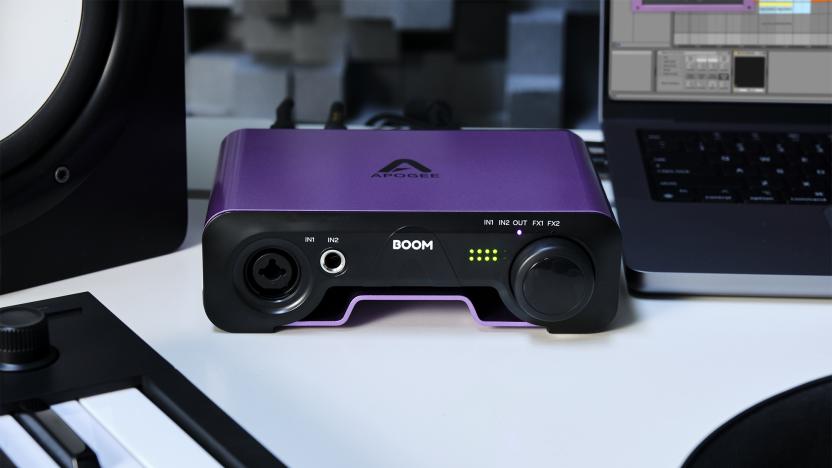
Apogee Boom brings its DSP-powered plugins to a budget-friendly audio interface
It looks like most audio interfaces, but the Boom packs a DSP without the pro price-tag.
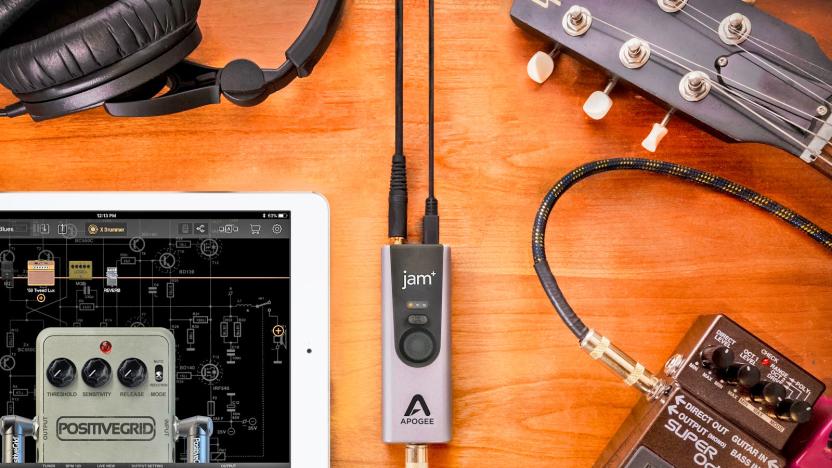
Apogee's Jam+ is an upgraded guitar input for iOS, Mac and Windows
If you're looking to employ any of the dozens of guitar apps to practice Stevie Ray Vaughn riffs, you'll need some sort of adapter to plug your axe into your phone, tablet or computer. Apogee debuted the Jam in 2011, a $99 thumbdrive-sized dongle that made it possible to play a guitar though an iOS device or Mac. The company would follow up with a pair of 96kHz models -- one for Windows and Mac and the other for Mac and iOS. Today, Apogee is revealing the latest version: the Jam+.
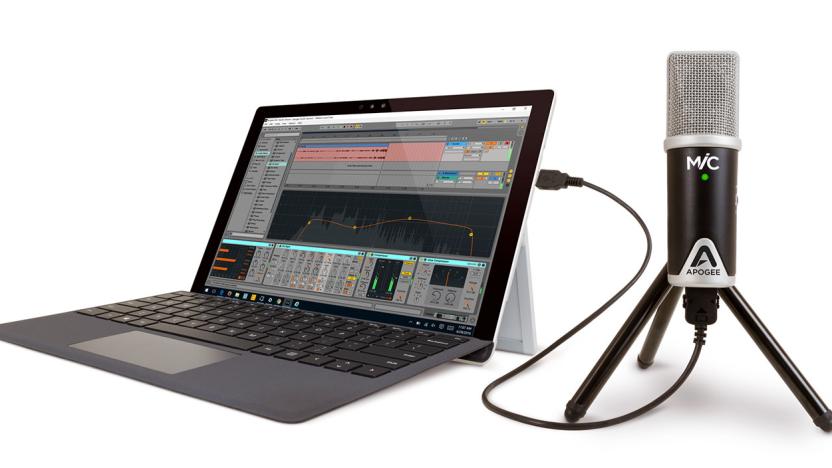
Apogee's new MiC 96k works with Windows for USB recording
Apogee has built a stellar reputation when it comes to audio gear. Back in 2014, the company debuted the MiC 96k: an updated version of its compact USB microphone that can handle up to 96kHz 24-bit analog-to-digital recording. That model only worked with iOS devices and Mac though, but now Apogee has a new MiC 96k that plays nice with Windows. The device carries the same name, design and features list, only now you can use it with your Surface or another Windows machine. The company focused on mobile for the first two MiCs, but now it's making sure there's a desktop option for everyone as well.
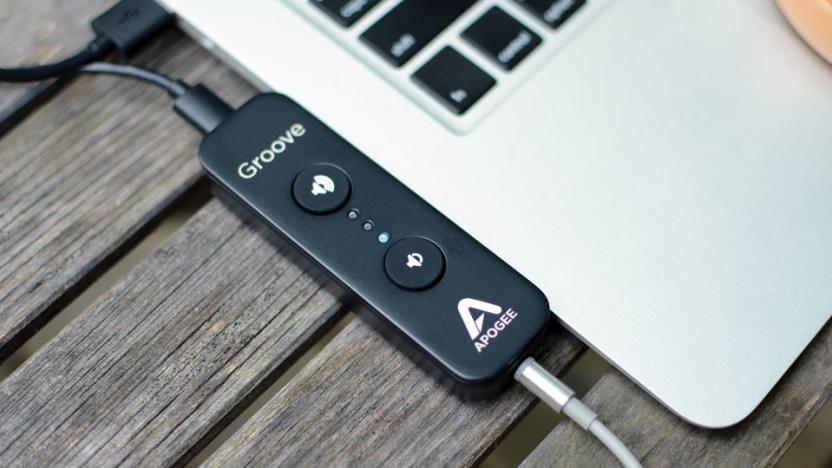
Apogee Groove improves headphone audio, for a price
It's been awhile since I've spent much time with Apogee's audio gear. In my early Engadget days, I reviewed both the Jam and MiC, two portable recording accessories that turned the iPad into a tracking center for guitars, vocals and podcasts. Earlier this year, the company revealed the Groove, putting years of pro audio experience to work improving subpar headphone audio. The diminutive metal device sits comfortably between your go-to headphones and laptop, providing a massive sound boost despite being about as small as a pack of gum. So, what's the catch? Well, if you're familiar with Apogee, you know its gear isn't cheap. Does the Groove provide enough oomph to warrant its $300 price tag? That depends on your listening habits.
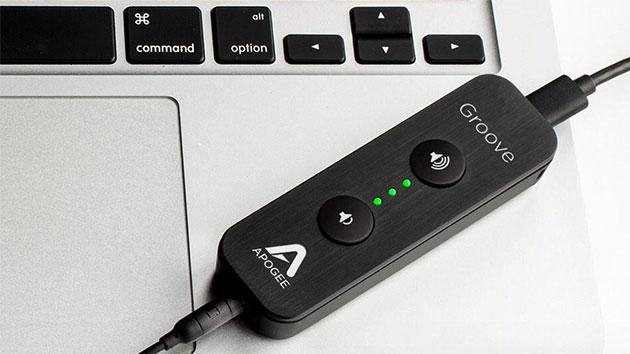
Apogee's tiny USB headphone amp is now available for $295
When it was announced back in January, Apogee promised to deliver its Groove USB headphone amp and digital-to-analong converter (DAC) this spring. Well, the company kept its word as the audio accessory is now available for $295. What does a few hundred dollars buy you? Groove touts up to 24 bit/192kHz audio thanks to a Quad Sum DAC that puts four converters on each channel to keep the audio sounding top notch. There's also a feature called Constant Current Drive that adapts to the frequencies of your headphones to make them sound better. On the front of the aluminum frame, volume controls and LEDs easily handle level changes and muting. What's more, the add-on is USB powered, so you won't have to futz with another cable or batteries -- just think of it a set of super-sized (and super powerful) in-line controls. The folks at Apogee have a knack for building stellar audio gear, so we're anxious to see how this gadget stacks up.

Apogee's USB headphone amp is an audio boost in a tiny package
If you're looking to improve the sound coming from your laptop while working on the go, Apogee may have the fix. At this week's NAMM trade show, the company announced Groove: a small USB digital-to-analog converter (DAC) and amp that aims to boost quality without taking up a considerable amount of extra room. In fact, the unit appears to be about the size of a thumb drive. Groove works with both Mac and PC, tackling up to 24 bit/192kHz audio for both headphones and powered speakers with on-board controls for muting and volume adjustments. The add-on is USB powered, so there's no need to worry about batteries or changing, and the aluminum frame houses Quad Sum DAC tech that uses four converters per channel to keep tracks crisp and clear. There's no word on pricing just yet, but the accessory is set to arrive this spring, and when it does, we'll be taking it for a test drive.

3D Realms returns with 32-game Anthology release
Once-defunct publisher 3D Realms has re-opened its doors, releasing a 32-game compilation and promising a slate of upcoming releases from a newly-assembled staff. The 3D Realms Anthology, available for $19.99 from the publisher's website, collects Duke Nukem 3D, Shadow Warrior, Commander Keen: Goodbye Galaxy, Wolfenstein 3D, Rise of the Triad: Dark War, and other classic PC games in a DRM-free package. Many of the company's past works -- including Alien Carnage, Major Stryker, and Stargunner -- are also available as free downloads. 3D Realms shed its former staff in 2008, but retained its rights to Duke Nukem and other landmark PC franchises. Rise of the Triad developer Interceptor Entertainment acquired label owner Apogee Software earlier this year, and now controls all associated IP and branding. [Video: 3D Realms]

You can now tinker with the code of 'Commander Keen's' lost episode
It's easy to indulge your Commander Keen nostalgia with most of the game series, but the "lost" Keen Dreams episode has proven elusive outside of less-than-official copies. As of now, though, you can do something about recreating those adventures through Tuberia -- Javier Chavez and team have fulfilled a crowdfunding promise by publishing legal source code for Keen Dreams' original DOS version. If you want, you can now port the game to newer platforms and otherwise tweak the code to your heart's content. Chavez and crew have yet to get their own ready-to-play edition going, but it's already up for consideration on Steam Greenlight. Consider giving it a thumbs-up if you want to resume your fight against the spud soldiers. [Image credit: Steve Hall, MobyGames]
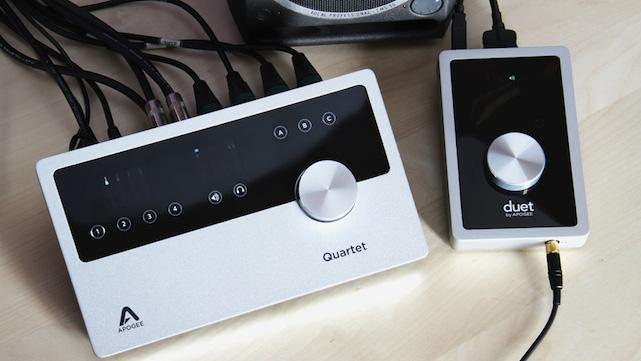
Apogee Duet and Quartet audio interfaces for Mac and iOS
Apogee's Duet (US$495) and Quartet ($1395) are the respective steps up from Apogee's ONE, a single input interface with a built-in condenser mic. You can check out the review of the ONE here, but suffice to say it's a high-quality interface for those looking for a compact and portable recording solution. With Apogee's premium reputation and price, I wanted to put the Duet and Quartet through a real-world recording environment test, with people who really know what to expect when it comes to recording audio. To help me do this I enlisted the help of three professionals who work in the music business day-in and day-out. Jonathan McMillan, a Canadian born, London-based mix and mastering engineer based at Blue Pro Mastering. Matt Weeks, London-based session musician and producer at WeeksWeeksWeeks. And finally, Paul Evans, a London-based session drummer, producer and programmer. With these three guys, there are years of professional recording experience in hand. The four of us spent the morning at Smokehouse Studios to see just what the Duet and Quartet have to offer. Hardware Where the ONE is a sturdy and solid piece of kit, there's no doubt that the Duet and Quartet take things to the next level. Both interfaces look and feel professional and premium. Where the ONE is made from plastic, the Duet and Quartet are encased in aluminum akin to Apple's Mac lineup. Via breakout cable, the Duet has 2 inputs (XLR and 1/4") and left and right (1/4") outputs. The inputs operate at 24-bit/192kHz recording. There's also a headphones output directly on the Duet interface, totaling 4 outputs with independent speaker and headphone outs. This multitude of outputs can be controlled and customized in Apogee's Maestro App. For example, a drummer could send himself a click track while sending the backing track to the front-of-house. All the spec details on the Duet can be found on Apogee's website, here. The Quartet has 4 inputs ((XLR and 1/4") and an additional 8 channels of digital input via optical connection (ADAT/SMUX), if you have an additional analog-to-digital converter kicking around. The Quartet has 6 balanced (1/4" TRS) outputs, which means you could hook up three different stereo monitor sets. All the spec details on the Quartet can be found at Apogee's website, here. Both interfaces have MIDI input via USB -- which the ONE missed out on -- high resolution OLED displays, assignable touch pads to speed up your workflow, and USB 2.0 connectivity, which Apogee says provides more than enough bandwidth to handle the talk between interface and Mac. Both interfaces use Apgoee's ESS Sabre32 32-bit Hyperstream DAC with Time Domain Jitter Eliminator technology, which Apogee says "offers unequalled dynamic range, ultra low distortion, and unmatched audio clarity free from input jitter." You can learn more about the technology here Finally, as with the ONE, both interfaces are iOS compatible, bringing Apogee's high-fidelity recording to the world of iOS. Both interfaces come with the required connectors and adaptors to connect to older and newer iPads and iPhones. Performance The goal of our test was to see how well the preamps and converters of the Duet and Quartet faired against a reference benchmark, which was Smokehouse Studio's Cadac E-Type console preamp running into a Radar iZ Corp. We ran the Duet and Quartet directly into Macs and the Cadac preamp went into the Radar converter. We recorded a vocal and guitar take through each of the interfaces using a Nuemann u47 for the vocal and a Nuemann u87 on the acoustic guitar. We then listened to and compared the results through the studio's monitors. At times it felt like we were splitting hairs, but we could all agree on the following conclusions: We found that while the Duet held up well as a 2-input interface in its price range, the Quartet produced noticeably better results. We found the Quartet had a clearer and more detailed quality than the Duet. Of course, the Quartet is more than double the price of the Duet, so in some respects that makes sense. However, we were disappointed to find that the Duet wasn't simply a 2-input version of what the Quartet has to offer. That being said, in no way did the Duet produce a sub-par sound. It's just that the Quartet had more to offer when it came to audio fidelity. As expected, against the studio's Radar converters and Cadac preamps, the Quartet didn't quite match up. However, there was discussion at length as to just how much of a difference there was and the different kinds of sounds that were produced. Naturally, the Cadac and Radar are world-class hardware, where as, as Apogee states, the Quartet is a class-leading product. Conclusion There's no doubt that the Duet and Quartet are fantastic recording interfaces that work seamlessly with OS X (and iOS). Both Matt and Paul said they'd happily use either on a recording project, where as Jonathan was a little more picky. However, out of the two we all agreed that we'd go for the Quartet on a project if we had the choice. If you're in the market for a 2-input interface, the Duet is a fantastic sounding and beautiful looking interface that produces high-quality results. It's super easy to use and has a wonderful on-board control and metering system. For those looking for two extra inputs and three stereo outputs for monitoring, the Quartet is steep in price, but worth every penny. We were truly impressed by the sound produced by the preamps and converters found in the Quartet. Coupled with the enhanced on-board control and metering option, the Quartet is a stand out interface. Honestly, you could get more inputs for less, but you'd likely struggle to match the quality the Quartet offers.
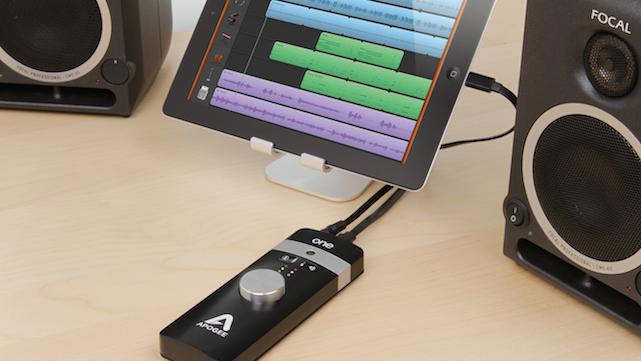
Apogee ONE: An audio interface and microphone for Mac and iOS
Apogee's revamped ONE (US$349) is a 2 IN 2 OUT USB audio interface with a built-in microphone for Mac and now iOS, too. This means you can plug the interface into your Mac or straight into your iPhone or iPad (via Apple's newer Lightning connector or the legacy 30-pin dock connector) to record audio. The ONE's built-in microphone means that you can get to recording straight away, without the need for additional cables or mics. Apogee is a name synonymous with high quality mic preamps, AD/DA converters and clocking found in its high-end studio products, like the Symphony. These products are used by professional musicians and studio engineers around the world. Does the ONE live up to the renowned name and reputation of Apogee? Read on to find out. Hardware The revamped ONE (2013) replaces Apogee's first generation ONE (2009), which had just the single input and was not compatible with iOS devices. The original ONE was USB 1.1 compatible, Mac: bus powered, had a 24 bit, 44.1/48kHz sample rate and cost US$249. The new ONE beats its predecessor in all aspects, except price -- it'll cost you a $100 more. Aside from that, it offers low-latency USB 2 speeds, it's DC mains or battery powered (in addition to Mac: bus powering) and, finally, the new ONE has a 24 bit, up to 96kHz sample rate. The ONE is constructed with a die-cast aluminum body, which feels strong and sturdy. It's not heavy, and it's not particularly large (though taller than the original ONE), which is a good thing since it's intended to be extremely portable. The molded rubber base doesn't allow the ONE to go slipping off of surfaces either. There's just a single, large dial on the front of the ONE, which is used to operate all aspects of the device, though all operations can be carried out via Apogee's Maestro app for Mac and iOS, too. Above the dial is an LED input / output level meter and above that an LED input / output indicator (internal mic, external mic, instrument and volume). When using the ONE's built-in mic, it was particularly useful to have the level meter on the front of the device to reference input levels, instead of looking to my Mac or iOS device to see if things were peaking or too low. On the top of the device is a microphone / instrument input (expandable via breakout cable), a micro USB input (to connect to a Mac or iOS device) and a DC power input. All cables and the power supply are included with the ONE. The bottom side of the device has a 1/8" stereo output for headphones or powered speakers. The ONE's breakout cable gives you a 1/4″ instrument IN and an XLR IN. The devices allows you to have 2 simultaneous inputs: the instrument IN and the XLR mic IN or the built-in mic with the instrument IN. Of course, you can just use the ONE's built-in mic without the breakout cable attached. On the rear of the device is a battery compartment for two AA batteries, though these were not included. Powering the ONE with batteries eliminates the power supply from the mix when using the ONE with an iOS device, which dramatically adds to its practicality in a portable context. One glaring omission is MIDI input, especially for a device that's iOS compatible. With so many apps designed for MIDI use on iOS, it feels like the ONE's missing a trick. Performance on iOS Connecting the ONE to my iPad was just as easy as connecting it to my Mac. However, the first hurdle was power. iPads and iPhones won't power the ONE like a Mac does, so I opted to use the included power supply (though I could have gone for the battery option had I any to hand). On the plus side, using the power supply with the ONE meant that my iPad was charging instead of draining away. The next step was downloading Apogee's Maestro app, which is required for Mac as well. The app allows you to control all features of the ONE as well as improving latency issues. Once Maestro was installed, I launched GarageBand and got to adjusting settings. It took me a little while to get a good level because I was unfamiliar with the Maestro app. I found myself repeatedly switching between GarageBand and Maestro, trying to get a level that didn't peak, but wasn't too quiet. I found this process cumbersome, but once I was a bit more familiar with Maestro, things seemed to improve. That being said, The Maestro app does feel like a bit of a third wheel. The interface is akin to its desktop counterpart. Although that may be a comfort to those who've used it on the Mac, it doesn't feel at home on iOS. Buttons and sliders are small, for example, particularly on the iPhone. It's still workable, but a Maestro app designed solely with iOS users in mind would go a long way to improving the experience. Performance on OS X Really, there's not much to say here. If you've used an Apogee interface with a Mac, you know it's a solid combination. The ONE felt right at home with my Mac. I can't put my finger on it -- maybe it was simply familiarity -- but everything worked as you'd expect it to. The Maestro app is still required, but it does fit much better in place on OS X than iOS. Results Once I got to some recording, I was really surprised with the results. Using a Rode NT 2000, I found I was getting some fantastic results for the first time on my iPad. Similarly, things sounded great on OS X running Logic. But for me, the big surprise was actually the ONE's built-in microphone. It admirably handled whatever I threw at it. Once I realized how compelling the built-in mic was, the ONE began to make sense to me. You see, there are many external mics for iOS out there, but the ONE's mic in combination with Apogee-designed preamps and digital audio converters makes it a compelling package for recording audio on iOS (or Mac). You really can just plug in and record. There's no need for additional cables or mics. And you do get a fantastic sound out of it. Conclusion Plugging the ONE straight into my Mac and putting something down at a moments notice is a real plus, especially when the quality of the audio sounds this good. More so, for those moments where it's easier to grab your iPhone or iPad, the ONE produces the same results. The revamped ONE carries Apogee's name well. For its class, it's got stand-out preamps and converters and a built-in mic that really impresses, with expandability if you need it. And all of this in a highly compact and portable form factor. If you're looking for that kind of convenience, but without skimping on quality, the ONE is a solid choice.

3D Realms responds to Gearbox, claims it owns Duke Nukem trademark
3D Realms isn't backing down from its most recent legal dispute with Gearbox, after the studio asserted it has the rights to develop its Duke Nukem game, and more than that, it has the sole rights to the Duke Nukem trademark. Following 3D Realms' tease of Duke Nukem: Mass Destruction, Gearbox announced it's suing the developer over unauthorized use of the Duke Nukem property and a violation of trademarks. In its complaint, Gearbox said 3D Realms sold the franchise rights to Gearbox in 2010 but then "sought to privately convince others that the sale never happened." 3D Realms filed its response to Gearbox last week, and the now Interceptor-owned studio provided Polygon with the following statement explaining its position: "On March 17, 2014, 3D Realms filed its answer to the complaint by Gearbox Software in Dallas, Texas. 3DR denies all allegations set forth in the complaint. In its answer, 3DR has submitted evidence showing that Gearbox at no point intended to enter into good faith negotiations but instead sought to force former owners, Scott Miller and George Broussard, to improperly surrender what rightfully belonged to 3DR. "It is our position that 3DR retains the right to develop the tentatively titled "Duke Nukem Survivor" game for specific platforms. This game was previously licensed for development to Interceptor Entertainment. Furthermore, it is our position that the Trademark for "Duke Nukem" was never assigned to Gearbox, but remains the sole property of 3DR." A spokesperson for Interceptor Entertainment explained "Duke Nukem Survivor" is the tentative title for Duke Nukem: Mass Destruction. Interceptor provided its own statement to Polygon, adding that "It's unfortunate that Gearbox has shown no intention of finding a peaceful solution with us. We will however continue to work towards a solution." Last month's legal action comes five months after 3D Realms and Gearbox's last dispute. 3D Realms filed a lawsuit against Gearbox in June 2013 over unpaid royalties from Duke Nukem Forever, only to withdraw it three months later after reviewing the evidence. [Image: Interceptor Entertainment]

3D Realms acquired by Rise of the Triad developer
Interceptor Entertainment, developer of the 2013 Rise of the Triad reboot, has acquired Apogee Software, who in turn owns the 3D Realms brand and formerly owned the Duke Nukem IP. The news was first reported by Danish newspaper Borsen, and confirmed on Twitter by Interceptor CEO Frederik Schreiber. Apogee/3D Realms recently became embroiled in a legal battle with Gearbox Software, the current owners of Duke. It's not clear how the acquisition will impact the ongoing legal battle, but Schreiber noted that Interceptor will have an official statement tomorrow. [Image: Apogee]

3DRealms drops lawsuit against Gearbox over Duke Nukem Forever royalties
There's been a lot of fallout from the Duke Nukem Forever launch in 2011, and not just from critics -- 3DRealms sued Gearbox earlier this year for allegedly skimping on royalties until it paid off a loan. All that's now water under the bridge, as 3DRealms has dismissed its lawsuit. The game developer's Scott Miller describes the suit as a "misunderstanding;" Gearbox is in the clear following an evidence review, he says. The dismissal may not patch things up with gamers, but it shows that industry disputes don't always have to reach a bitter conclusion. Read 3DRealms' full statement after the break.

Rise of the Triad out this summer, here's what you'll need to play it
The release window for Apogee Software and Interceptor Entertainment's revival of Rise of the Triad has been narrowed from sometime this year to sometime this summer, it was announced on the game's official blog today. Also unveiled, in addition to the homage cover artwork above, was the fact that RotT will be available simultaneously on Steam, GOG and Green Man Gaming upon launch. In order to run it, first-person nostalgia aficionados will need a minimum of two gigs of RAM and either a Radeon HD 3870 or an NVIDIA 8800 GT, plugged into the same motherboard as a 2.4 GHz dual-core processor running Windows XP or newer. For the best experience, double the RAM, bump up to the 64-bit version of Windows 7 and drop in a Radeon HD 6950 or GeForce GTX 560.

Duke Nukem 2 hits iOS next month
Duke Nukem's two-dimensional VGA romp through the alien-ridden, distant future year of 1998 is coming to various iOS devices next month, in celebration of the game's twentieth anniversary. Originally released in 1993 for MS-DOS, Duke Nukem 2 will be available for $1.99 and will be compatible with iOS devices iPhone 4S and newer, including iPad Minis and last-generation's iPod Touch.As seen in the trailer above, Interceptor Entertainment's iOS port uses virtual button controls to navigate Duke through the game's 32 levels. While Duke's pre-3D adventures were a little bit more Contra than they were Doom, the franchise's sense of humor had already been firmly cemented in place, much like his hairstyle.

Apogee One for iOS and Mac hands-on
Apogee strolled into NAMM with a trio of audio interfaces newly outfitted for both iOS and Mac. While the Duet and Quartet are certainly formidable pieces of recording kit, the more compact Apogee One caught our eye for its dual capture ability without adding too much heft to the ol' backpack. The unit accepts input from a built-in mic and either a XLR or 1/4-inch analog input -- both of which connect via a two-headed Y-cable. From there, the One connects to a power supply and either your iPad, iPhone, iPod touch or Apple computer of choice for that dual-tracking capture. After seeing the device up close and spending a few minutes handling it, our main gripe remains the lack of a Lightning connection. Sure it's great that we can outfit our iDevices, but we'd love to see an included cable for the latest port to come out of Cupertino rather having to locate an adapter. Without being able to capture a solid vocal track on the bustling show floor here at NAMM, we unfortunately can't speak to the quality of that on-board condenser microphone. However, the One seemed to handle guitar licks quite well when recorded with GarageBand on an iPad mini. As we've mentioned before, the outfit has also outed its Maestro app for low-latency monitoring and a bit more control over how matters progress. Aside from all of that, the gadget sports a similar dial knob to that of the original release for selecting functions and controlling input / output levels with dual LED stacks for a visual indicator of said signals. The One wields the same solid build quality that we've come to expect from Apogee based on a few of the other products we've spent extended time with. For a quick walkthrough, take a look at the video that lies beyond the break.

Apogee revamps One and Duet audio interfaces for iOS and Mac, updates Quartet to match
Apogee wants bring pro audio interfaces to the mobile realm. To that end, it's coming to NAMM with a trio of options that cover most Apple-bound musicians and podcasters. Its next-generation One interface (seen after the break) can take simultaneous input from both a built-in condenser mic and one device plugged into either an XLR or quarter-inch jack, passing along the resulting tunes to an iOS device or a Mac's USB port. A similarly reworked Duet adds direct iOS connections to the two-input, four-output Duet (above). Full-fledged bands aren't left out of the equation, either -- the existing, four-input Quartet has received iPad support without changing its formula. Lighting-based iOS gear unfortunately requires an adapter, but we'll take consolation in a new Maestro app for iPads that offers control over connections and session monitoring. Producers hoping for more mobility can pick up the Duet or Quartet in February at their respective $595 and $1,295 prices, although they'll have to wait until March to buy the One at $349.

Engadget holiday gift guide 2012: accessories
Welcome to the Engadget holiday gift guide! Picking presents for friends and loved ones is never a simple task, and with thousands of options for each category, buying technology can be an especially frustrating experience. We're here to help. Below you'll find today's bevy of curated picks, and you can head back to our hub to see the rest of the product guides as they're added throughout the holiday season. And don't forget to enter our giveaway -- leave a comment for a chance to nab AT&T's LG Optimus G. Sure, Ultrabooks and Windows 8 tablets are flashy gift options, but it's extras like the ones found here that really make 'em sing. Whether it's a desktop or portable storage solution, a smart thermostat or a secondary camera for those more experimental shots, we've got you covered. This collection of high-tech add-ons will surely snag the attention of anyone on your holiday shopping list, so mosey on past the break to start perusing.

Rise of the Triad 60% off on GOG
Apogee's 1994 first-person shooter, Rise of the Triad: Dark War, is 60% off on GOG.com today. Those gearing up for the eventual return of the game courtesy of Interceptor Entertainment, as announced at QuakeCon this year, have until 10:59am GMT tomorrow to pick up the original game for $2.39.The DRM-free download comes with the game's soundtrack and seven extra levels, so saving $3.60 never felt better (especially if you buy a burrito with that extra money like we will).









